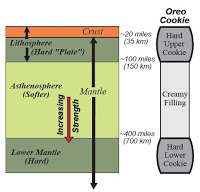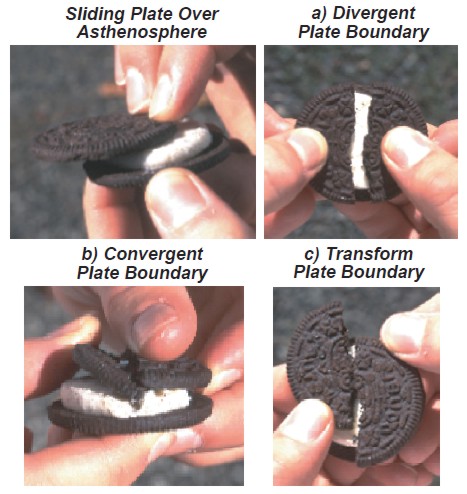Understanding Earthquakes and Volcanoes… with snack foods! (Part 1)
There are some easy ways to demonstrate how volcanoes and earthquakes work! Last year I was fortunate to work with Oregon State’s Robert Lillie, a Professor of Geology and Public Interpretation. To help the public understand how earthquakes and volcanoes are created with plate tectonics, he developed some simple visuals using snack foods. The first part in this two part series will discuss plate boundaries using double-stuffed Oreo cookies.
 Simulating plate boundaries with Oreo cookies. The upper cookie is the lithosphere, the creamy filling the asthenosphere, and the lower cookie the lower mantle. Carefully remove the upper cookie with a “twisting” motion. Slide the upper cookie over the creamy filling to simulate motion of a rigid lithospheric plate over the softer asthenosphere. Next, break the upper cookie in half. As you do so, listen to the sound it makes. What does that sound represent? An earthquake. It takes cold, brittle lithosphere to make earthquakes – earthquakes do not occur in the soft, flowing asthenosphere.
Simulating plate boundaries with Oreo cookies. The upper cookie is the lithosphere, the creamy filling the asthenosphere, and the lower cookie the lower mantle. Carefully remove the upper cookie with a “twisting” motion. Slide the upper cookie over the creamy filling to simulate motion of a rigid lithospheric plate over the softer asthenosphere. Next, break the upper cookie in half. As you do so, listen to the sound it makes. What does that sound represent? An earthquake. It takes cold, brittle lithosphere to make earthquakes – earthquakes do not occur in the soft, flowing asthenosphere.
 a) Divergent plate boundary, push down on the two broken cookie halves and slide them apart. Notice that the creamy filling between the two broken “plates” may tend to flow upward, similar to the rising, decompression, and partial melting of hot asthenosphere at mid-ocean ridges and continental rift zones. (Ex: Iceland)
a) Divergent plate boundary, push down on the two broken cookie halves and slide them apart. Notice that the creamy filling between the two broken “plates” may tend to flow upward, similar to the rising, decompression, and partial melting of hot asthenosphere at mid-ocean ridges and continental rift zones. (Ex: Iceland)
b) Convergent plate boundary, push one cookie piece beneath the other. This is the only situation where the cold, brittle lithosphere extends to great depths, and hence the only place where deep earthquakes occur. The very largest earthquakes are at subduction zones where two plates get stuck together for centuries, then suddenly let go. (Ex: Western Oregon)
c) Transform plate boundary, slide the two cookie pieces laterally past one another, over the creamy filling. You can feel and hear that the “plates” do not slide smoothly past one another, but rather stick then let go, stick then let go. (Ex: San Andreas Fault in California)
Additionally, a Hotspot can be simulated with the demonstration in the upper left photo. Imagine if a piece of hot, glowing coal were embedded in the creamy filling – a chain of “volcanoes” would be burned into the overriding cookie. (Ex: The Hawaiian Islands, Yellowstone)
For more information, click here!
6 comments
Clever!
What is it when you dunk the cookie in milk? Oceanic subduction?
This is AWESOME. I teach English as a Second Language to 5th graders and we are always looking for hands-on activity to help teach the material. I've already told my fellow teachers to put this on the plan for next year!
The milk? I guess that would be when the sun goes supernova, destroying the structure but providing a tasty template suitable for new creation? 🙂 Okay- that sounds horrible!
This lesson was actually featured in the Oregonian a few years back, however really helps with all the news going around about earthquakes and volcanoes. If only the ash cloud was made of oreo crumbles…
hi – it's karen from RedCrossTalks. We love this oreo blog – ee're going to post it on ours today! Let me know if it's a problem!
It's public information- just make sure to reference Robert Lillie instead of myself or the PDX Cross blog. Thanks!
What a great discription of an earthquake. It does make it easy for anyone. I like what Teresa said about using it in her classroom. The classroom is a great place for children to learn about earthquakes. I just saw a demonstration about an earthquake simulator. In it there were things that were loose and other things that had been held with safety straps. I hope that all schools have taken the steps needed to protect everyone from falling itmes during a quake.
Good luck to everyone and I'll look forward to more blogs from Scott Waggoner.
Comments are closed.